Reflection on Qantas Airline: Ethical Leadership and Values
VerifiedAdded on 2020/05/16
|11
|2850
|105
Report
AI Summary
This report provides a reflection on Qantas Airline, focusing on its ethical leadership, social sustainability, and environmental impact. The analysis highlights concerns regarding employee morale, pay, and ethical leadership within the organization. The author recommends improvements such as fostering emotional intelligence, promoting visionary leadership, and restoring nobility within the workforce. The report draws parallels to the Captain Planet series to illustrate the importance of unity, collaboration, and deep connections in achieving sustainability goals. It also discusses the significance of moral leadership, strategic management, and internal/external analysis in achieving organizational success. The report further explores the role of ethics in environmental sustainability, corporate environmental sustainability, and social sustainability, emphasizing the need for ethical considerations, environmental protection, and equitable access to resources. The report concludes by underscoring the importance of integrating these dimensions for a sustainable future, drawing attention to the need for a cohesive framework to guide sustainability efforts.
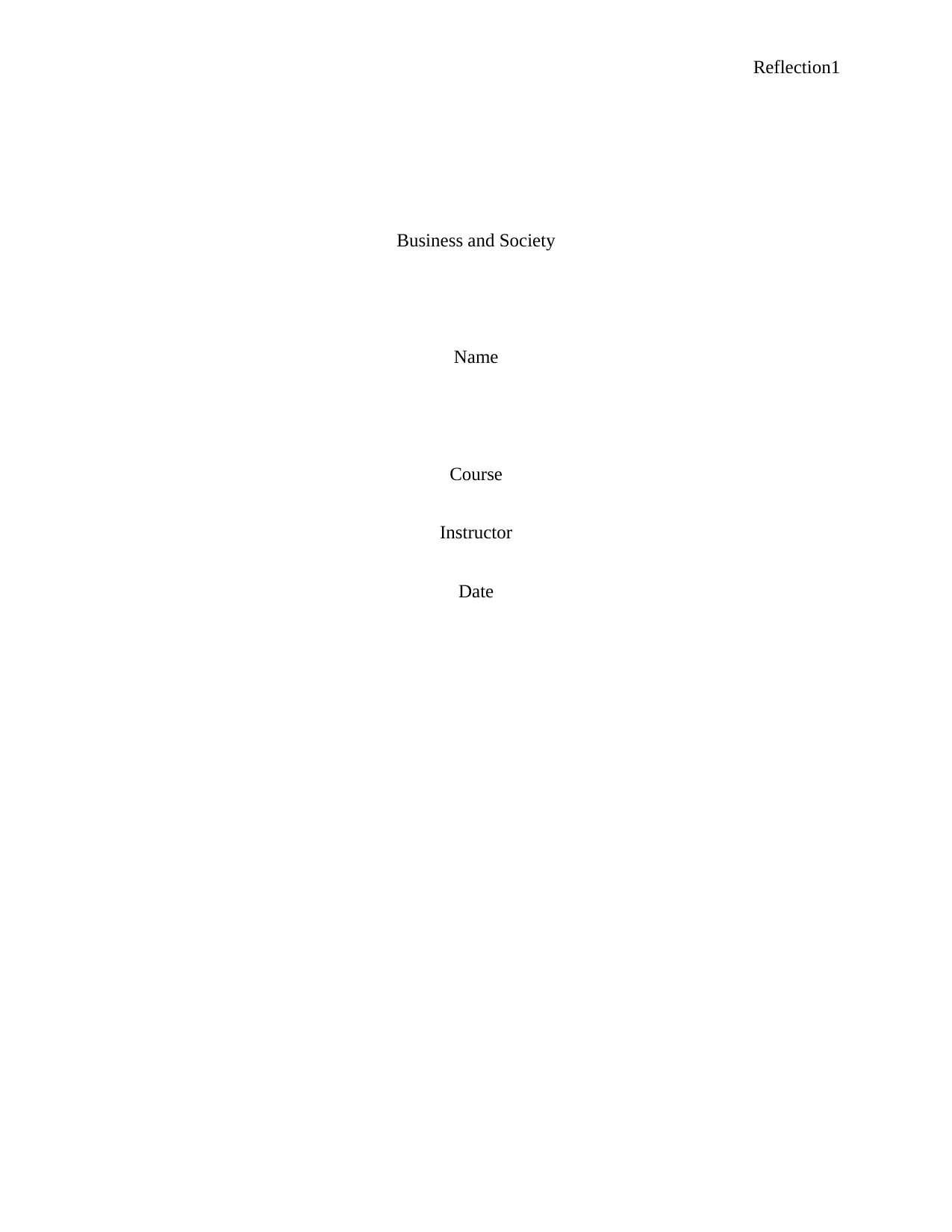
Reflection1
Business and Society
Name
Course
Instructor
Date
Business and Society
Name
Course
Instructor
Date
Paraphrase This Document
Need a fresh take? Get an instant paraphrase of this document with our AI Paraphraser
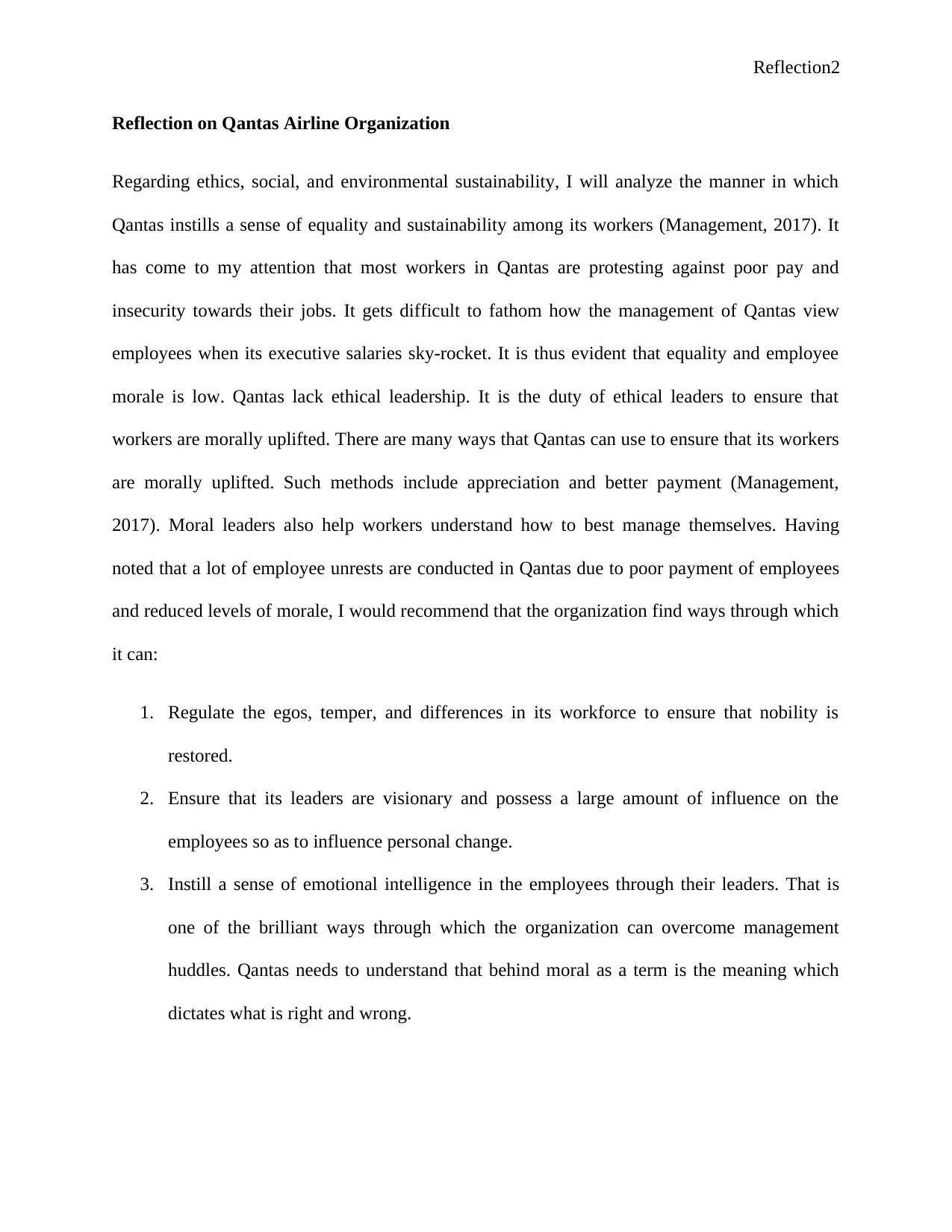
Reflection2
Reflection on Qantas Airline Organization
Regarding ethics, social, and environmental sustainability, I will analyze the manner in which
Qantas instills a sense of equality and sustainability among its workers (Management, 2017). It
has come to my attention that most workers in Qantas are protesting against poor pay and
insecurity towards their jobs. It gets difficult to fathom how the management of Qantas view
employees when its executive salaries sky-rocket. It is thus evident that equality and employee
morale is low. Qantas lack ethical leadership. It is the duty of ethical leaders to ensure that
workers are morally uplifted. There are many ways that Qantas can use to ensure that its workers
are morally uplifted. Such methods include appreciation and better payment (Management,
2017). Moral leaders also help workers understand how to best manage themselves. Having
noted that a lot of employee unrests are conducted in Qantas due to poor payment of employees
and reduced levels of morale, I would recommend that the organization find ways through which
it can:
1. Regulate the egos, temper, and differences in its workforce to ensure that nobility is
restored.
2. Ensure that its leaders are visionary and possess a large amount of influence on the
employees so as to influence personal change.
3. Instill a sense of emotional intelligence in the employees through their leaders. That is
one of the brilliant ways through which the organization can overcome management
huddles. Qantas needs to understand that behind moral as a term is the meaning which
dictates what is right and wrong.
Reflection on Qantas Airline Organization
Regarding ethics, social, and environmental sustainability, I will analyze the manner in which
Qantas instills a sense of equality and sustainability among its workers (Management, 2017). It
has come to my attention that most workers in Qantas are protesting against poor pay and
insecurity towards their jobs. It gets difficult to fathom how the management of Qantas view
employees when its executive salaries sky-rocket. It is thus evident that equality and employee
morale is low. Qantas lack ethical leadership. It is the duty of ethical leaders to ensure that
workers are morally uplifted. There are many ways that Qantas can use to ensure that its workers
are morally uplifted. Such methods include appreciation and better payment (Management,
2017). Moral leaders also help workers understand how to best manage themselves. Having
noted that a lot of employee unrests are conducted in Qantas due to poor payment of employees
and reduced levels of morale, I would recommend that the organization find ways through which
it can:
1. Regulate the egos, temper, and differences in its workforce to ensure that nobility is
restored.
2. Ensure that its leaders are visionary and possess a large amount of influence on the
employees so as to influence personal change.
3. Instill a sense of emotional intelligence in the employees through their leaders. That is
one of the brilliant ways through which the organization can overcome management
huddles. Qantas needs to understand that behind moral as a term is the meaning which
dictates what is right and wrong.

Reflection3
From my point of view, it is clear that the ability to distinguish the right from wrong is
considered elusive by Qantas. Such is true considering how the organization manages its issues
to do with competing needs. It is quite elaborate in case of Qantas that employees do not feel
valued by the organization. In such a case, trust for the leaders is reduced and workers don’t
understand the direction of programs allocated for them (Price, 2011). Leadership should be
about being effective and setting good examples.
For further recommendations, I would wish to use the case of Captain Planet and the Planeteers
to draw vivid conclusions and lessons that Qantas Organization needs to learn from. Some of
the lessons include:
1. Unity leads to rich diversity
The actual animation of captain planet combined a number of Planeteers. These individuals were
ring bearers of the five elemental rings. The storyline clearly shows that the five Planeteers were
chosen on the basis of their first encounters with natural issues. It is, therefore clear that a
dynamic team is composed of individuals who are not mirror images of themselves. A team
always brings together individuals with different experiences, skills, and knowledge thereby
increasing the chances of problem solving. A group also ensures that members can learn a lot
from each other’s experiences and also accept who they are (Kader, 2017).
2. The collaborative power
Collaboration is very important as a tool. Individualism only leads to retarded growth. For
instance, when the Planeteers worked alone, they got things done slowly with their own
elements. However, whenever they couldn’t get things resolved on their own, they summoned
Captain Planet by combining forces. Such instances teach us that teamwork is more solid
From my point of view, it is clear that the ability to distinguish the right from wrong is
considered elusive by Qantas. Such is true considering how the organization manages its issues
to do with competing needs. It is quite elaborate in case of Qantas that employees do not feel
valued by the organization. In such a case, trust for the leaders is reduced and workers don’t
understand the direction of programs allocated for them (Price, 2011). Leadership should be
about being effective and setting good examples.
For further recommendations, I would wish to use the case of Captain Planet and the Planeteers
to draw vivid conclusions and lessons that Qantas Organization needs to learn from. Some of
the lessons include:
1. Unity leads to rich diversity
The actual animation of captain planet combined a number of Planeteers. These individuals were
ring bearers of the five elemental rings. The storyline clearly shows that the five Planeteers were
chosen on the basis of their first encounters with natural issues. It is, therefore clear that a
dynamic team is composed of individuals who are not mirror images of themselves. A team
always brings together individuals with different experiences, skills, and knowledge thereby
increasing the chances of problem solving. A group also ensures that members can learn a lot
from each other’s experiences and also accept who they are (Kader, 2017).
2. The collaborative power
Collaboration is very important as a tool. Individualism only leads to retarded growth. For
instance, when the Planeteers worked alone, they got things done slowly with their own
elements. However, whenever they couldn’t get things resolved on their own, they summoned
Captain Planet by combining forces. Such instances teach us that teamwork is more solid
⊘ This is a preview!⊘
Do you want full access?
Subscribe today to unlock all pages.

Trusted by 1+ million students worldwide
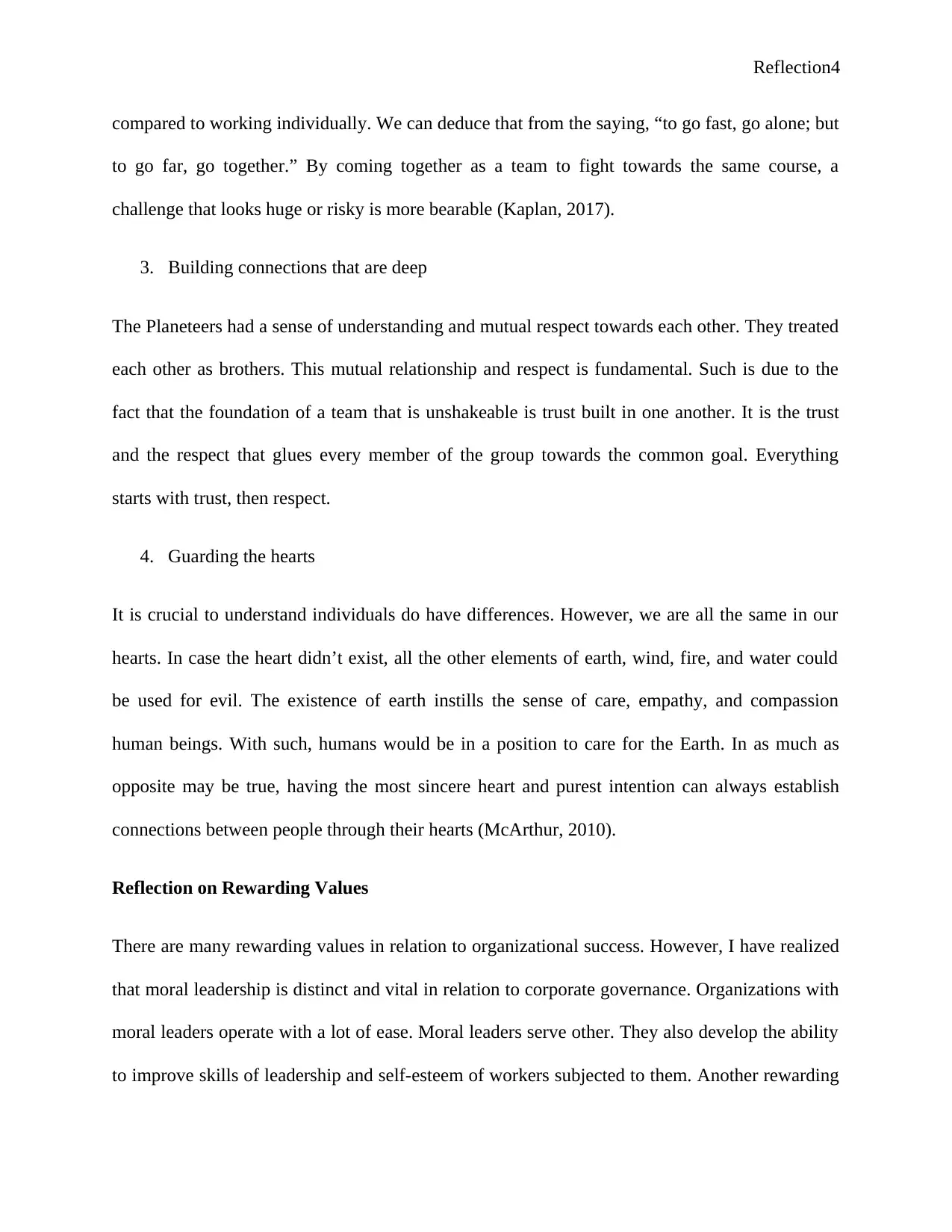
Reflection4
compared to working individually. We can deduce that from the saying, “to go fast, go alone; but
to go far, go together.” By coming together as a team to fight towards the same course, a
challenge that looks huge or risky is more bearable (Kaplan, 2017).
3. Building connections that are deep
The Planeteers had a sense of understanding and mutual respect towards each other. They treated
each other as brothers. This mutual relationship and respect is fundamental. Such is due to the
fact that the foundation of a team that is unshakeable is trust built in one another. It is the trust
and the respect that glues every member of the group towards the common goal. Everything
starts with trust, then respect.
4. Guarding the hearts
It is crucial to understand individuals do have differences. However, we are all the same in our
hearts. In case the heart didn’t exist, all the other elements of earth, wind, fire, and water could
be used for evil. The existence of earth instills the sense of care, empathy, and compassion
human beings. With such, humans would be in a position to care for the Earth. In as much as
opposite may be true, having the most sincere heart and purest intention can always establish
connections between people through their hearts (McArthur, 2010).
Reflection on Rewarding Values
There are many rewarding values in relation to organizational success. However, I have realized
that moral leadership is distinct and vital in relation to corporate governance. Organizations with
moral leaders operate with a lot of ease. Moral leaders serve other. They also develop the ability
to improve skills of leadership and self-esteem of workers subjected to them. Another rewarding
compared to working individually. We can deduce that from the saying, “to go fast, go alone; but
to go far, go together.” By coming together as a team to fight towards the same course, a
challenge that looks huge or risky is more bearable (Kaplan, 2017).
3. Building connections that are deep
The Planeteers had a sense of understanding and mutual respect towards each other. They treated
each other as brothers. This mutual relationship and respect is fundamental. Such is due to the
fact that the foundation of a team that is unshakeable is trust built in one another. It is the trust
and the respect that glues every member of the group towards the common goal. Everything
starts with trust, then respect.
4. Guarding the hearts
It is crucial to understand individuals do have differences. However, we are all the same in our
hearts. In case the heart didn’t exist, all the other elements of earth, wind, fire, and water could
be used for evil. The existence of earth instills the sense of care, empathy, and compassion
human beings. With such, humans would be in a position to care for the Earth. In as much as
opposite may be true, having the most sincere heart and purest intention can always establish
connections between people through their hearts (McArthur, 2010).
Reflection on Rewarding Values
There are many rewarding values in relation to organizational success. However, I have realized
that moral leadership is distinct and vital in relation to corporate governance. Organizations with
moral leaders operate with a lot of ease. Moral leaders serve other. They also develop the ability
to improve skills of leadership and self-esteem of workers subjected to them. Another rewarding
Paraphrase This Document
Need a fresh take? Get an instant paraphrase of this document with our AI Paraphraser
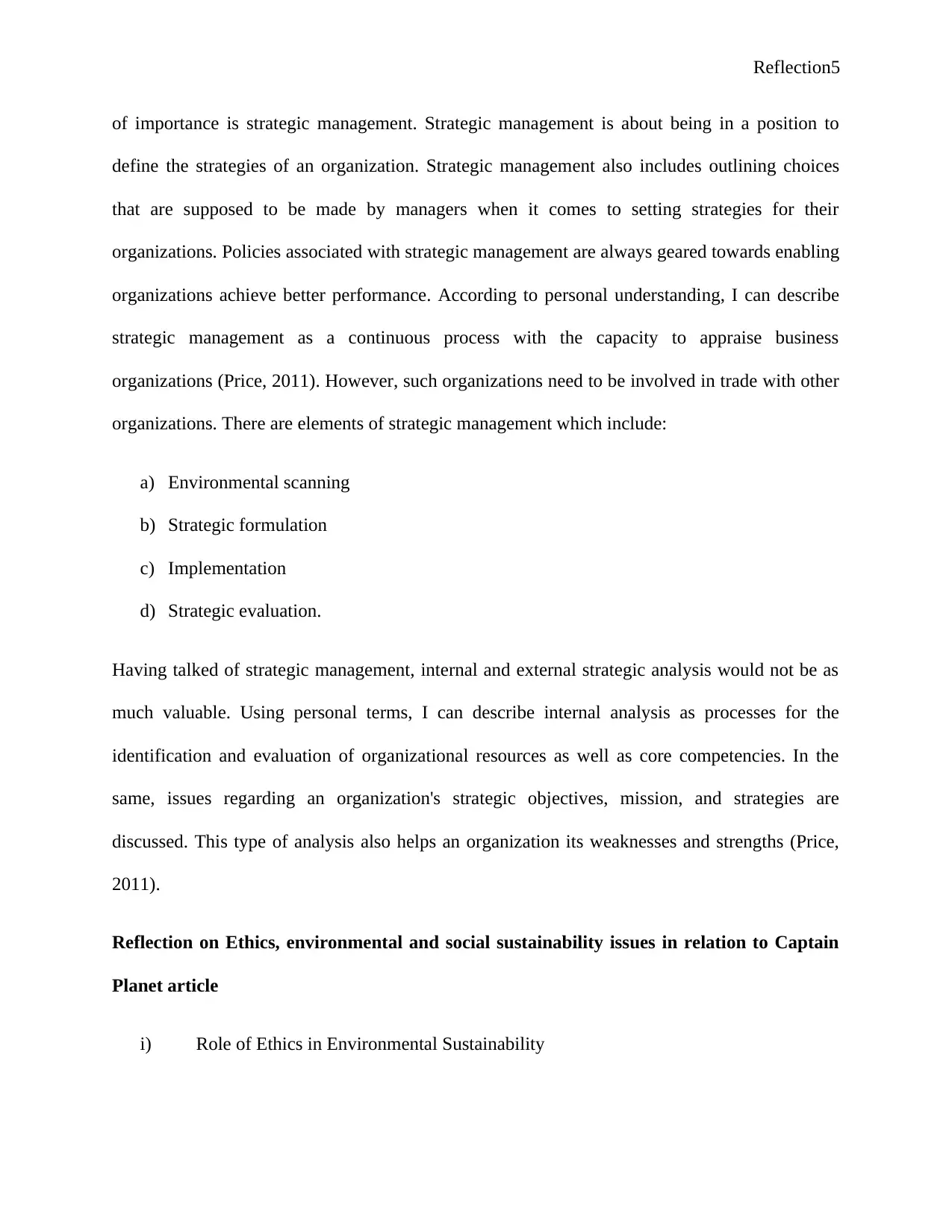
Reflection5
of importance is strategic management. Strategic management is about being in a position to
define the strategies of an organization. Strategic management also includes outlining choices
that are supposed to be made by managers when it comes to setting strategies for their
organizations. Policies associated with strategic management are always geared towards enabling
organizations achieve better performance. According to personal understanding, I can describe
strategic management as a continuous process with the capacity to appraise business
organizations (Price, 2011). However, such organizations need to be involved in trade with other
organizations. There are elements of strategic management which include:
a) Environmental scanning
b) Strategic formulation
c) Implementation
d) Strategic evaluation.
Having talked of strategic management, internal and external strategic analysis would not be as
much valuable. Using personal terms, I can describe internal analysis as processes for the
identification and evaluation of organizational resources as well as core competencies. In the
same, issues regarding an organization's strategic objectives, mission, and strategies are
discussed. This type of analysis also helps an organization its weaknesses and strengths (Price,
2011).
Reflection on Ethics, environmental and social sustainability issues in relation to Captain
Planet article
i) Role of Ethics in Environmental Sustainability
of importance is strategic management. Strategic management is about being in a position to
define the strategies of an organization. Strategic management also includes outlining choices
that are supposed to be made by managers when it comes to setting strategies for their
organizations. Policies associated with strategic management are always geared towards enabling
organizations achieve better performance. According to personal understanding, I can describe
strategic management as a continuous process with the capacity to appraise business
organizations (Price, 2011). However, such organizations need to be involved in trade with other
organizations. There are elements of strategic management which include:
a) Environmental scanning
b) Strategic formulation
c) Implementation
d) Strategic evaluation.
Having talked of strategic management, internal and external strategic analysis would not be as
much valuable. Using personal terms, I can describe internal analysis as processes for the
identification and evaluation of organizational resources as well as core competencies. In the
same, issues regarding an organization's strategic objectives, mission, and strategies are
discussed. This type of analysis also helps an organization its weaknesses and strengths (Price,
2011).
Reflection on Ethics, environmental and social sustainability issues in relation to Captain
Planet article
i) Role of Ethics in Environmental Sustainability
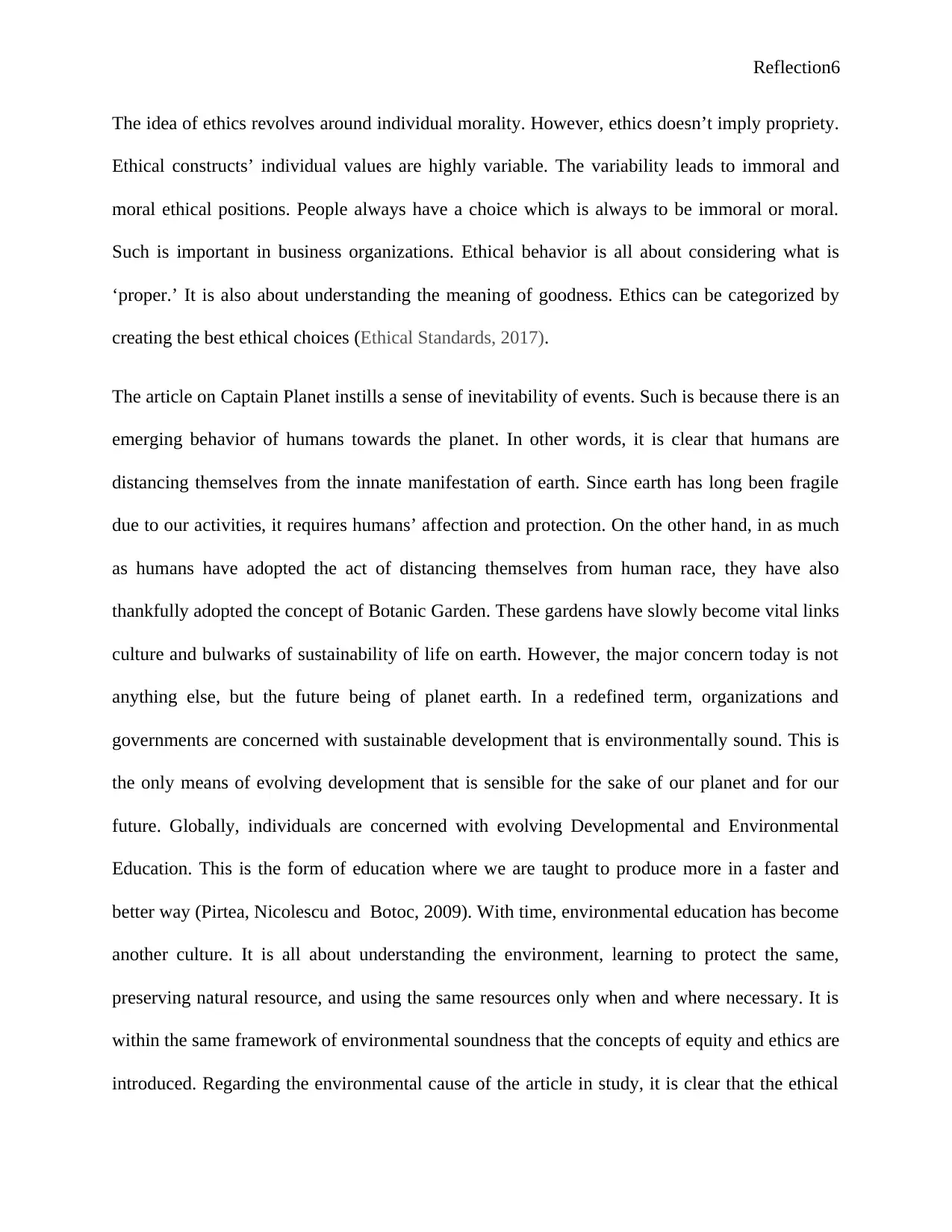
Reflection6
The idea of ethics revolves around individual morality. However, ethics doesn’t imply propriety.
Ethical constructs’ individual values are highly variable. The variability leads to immoral and
moral ethical positions. People always have a choice which is always to be immoral or moral.
Such is important in business organizations. Ethical behavior is all about considering what is
‘proper.’ It is also about understanding the meaning of goodness. Ethics can be categorized by
creating the best ethical choices (Ethical Standards, 2017).
The article on Captain Planet instills a sense of inevitability of events. Such is because there is an
emerging behavior of humans towards the planet. In other words, it is clear that humans are
distancing themselves from the innate manifestation of earth. Since earth has long been fragile
due to our activities, it requires humans’ affection and protection. On the other hand, in as much
as humans have adopted the act of distancing themselves from human race, they have also
thankfully adopted the concept of Botanic Garden. These gardens have slowly become vital links
culture and bulwarks of sustainability of life on earth. However, the major concern today is not
anything else, but the future being of planet earth. In a redefined term, organizations and
governments are concerned with sustainable development that is environmentally sound. This is
the only means of evolving development that is sensible for the sake of our planet and for our
future. Globally, individuals are concerned with evolving Developmental and Environmental
Education. This is the form of education where we are taught to produce more in a faster and
better way (Pirtea, Nicolescu and Botoc, 2009). With time, environmental education has become
another culture. It is all about understanding the environment, learning to protect the same,
preserving natural resource, and using the same resources only when and where necessary. It is
within the same framework of environmental soundness that the concepts of equity and ethics are
introduced. Regarding the environmental cause of the article in study, it is clear that the ethical
The idea of ethics revolves around individual morality. However, ethics doesn’t imply propriety.
Ethical constructs’ individual values are highly variable. The variability leads to immoral and
moral ethical positions. People always have a choice which is always to be immoral or moral.
Such is important in business organizations. Ethical behavior is all about considering what is
‘proper.’ It is also about understanding the meaning of goodness. Ethics can be categorized by
creating the best ethical choices (Ethical Standards, 2017).
The article on Captain Planet instills a sense of inevitability of events. Such is because there is an
emerging behavior of humans towards the planet. In other words, it is clear that humans are
distancing themselves from the innate manifestation of earth. Since earth has long been fragile
due to our activities, it requires humans’ affection and protection. On the other hand, in as much
as humans have adopted the act of distancing themselves from human race, they have also
thankfully adopted the concept of Botanic Garden. These gardens have slowly become vital links
culture and bulwarks of sustainability of life on earth. However, the major concern today is not
anything else, but the future being of planet earth. In a redefined term, organizations and
governments are concerned with sustainable development that is environmentally sound. This is
the only means of evolving development that is sensible for the sake of our planet and for our
future. Globally, individuals are concerned with evolving Developmental and Environmental
Education. This is the form of education where we are taught to produce more in a faster and
better way (Pirtea, Nicolescu and Botoc, 2009). With time, environmental education has become
another culture. It is all about understanding the environment, learning to protect the same,
preserving natural resource, and using the same resources only when and where necessary. It is
within the same framework of environmental soundness that the concepts of equity and ethics are
introduced. Regarding the environmental cause of the article in study, it is clear that the ethical
⊘ This is a preview!⊘
Do you want full access?
Subscribe today to unlock all pages.

Trusted by 1+ million students worldwide
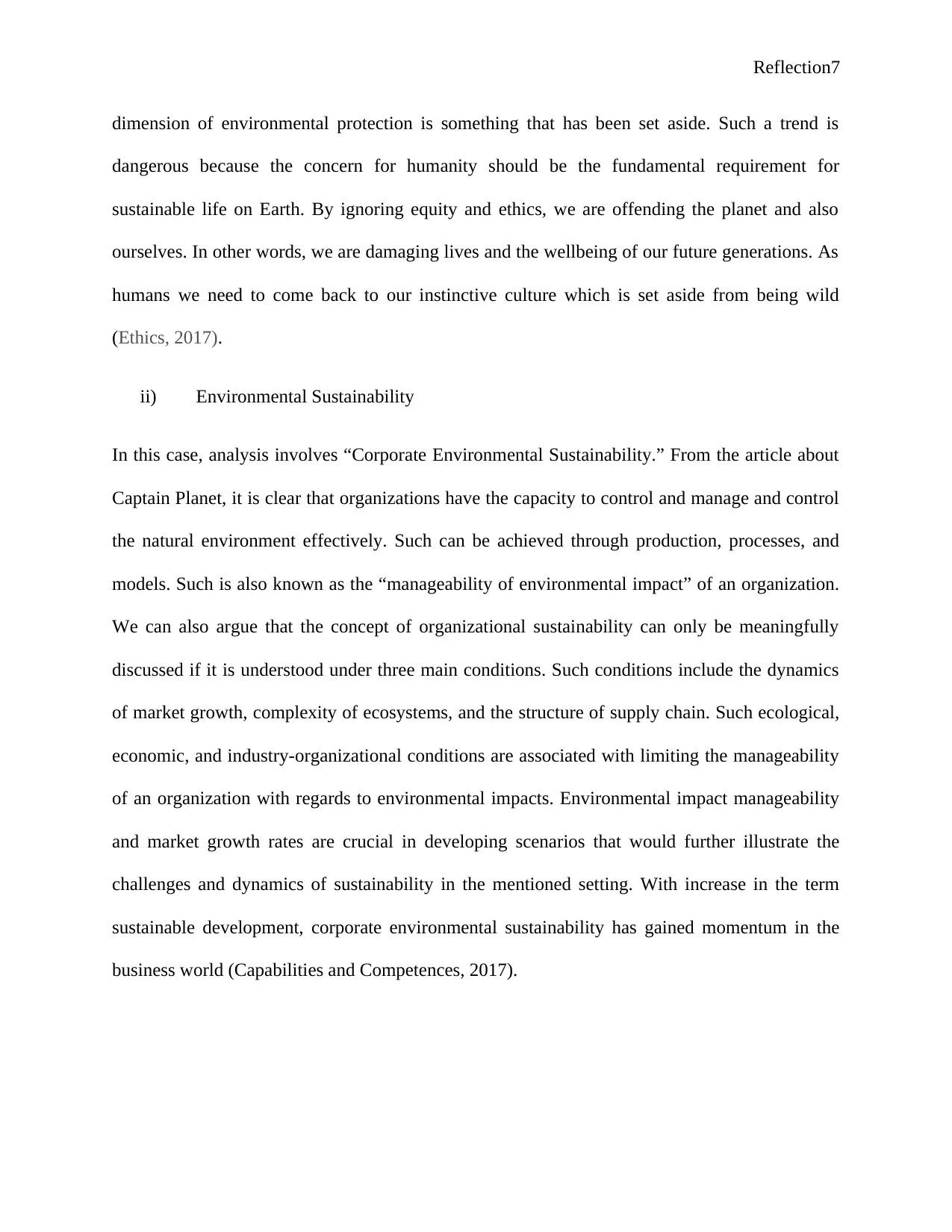
Reflection7
dimension of environmental protection is something that has been set aside. Such a trend is
dangerous because the concern for humanity should be the fundamental requirement for
sustainable life on Earth. By ignoring equity and ethics, we are offending the planet and also
ourselves. In other words, we are damaging lives and the wellbeing of our future generations. As
humans we need to come back to our instinctive culture which is set aside from being wild
(Ethics, 2017).
ii) Environmental Sustainability
In this case, analysis involves “Corporate Environmental Sustainability.” From the article about
Captain Planet, it is clear that organizations have the capacity to control and manage and control
the natural environment effectively. Such can be achieved through production, processes, and
models. Such is also known as the “manageability of environmental impact” of an organization.
We can also argue that the concept of organizational sustainability can only be meaningfully
discussed if it is understood under three main conditions. Such conditions include the dynamics
of market growth, complexity of ecosystems, and the structure of supply chain. Such ecological,
economic, and industry-organizational conditions are associated with limiting the manageability
of an organization with regards to environmental impacts. Environmental impact manageability
and market growth rates are crucial in developing scenarios that would further illustrate the
challenges and dynamics of sustainability in the mentioned setting. With increase in the term
sustainable development, corporate environmental sustainability has gained momentum in the
business world (Capabilities and Competences, 2017).
dimension of environmental protection is something that has been set aside. Such a trend is
dangerous because the concern for humanity should be the fundamental requirement for
sustainable life on Earth. By ignoring equity and ethics, we are offending the planet and also
ourselves. In other words, we are damaging lives and the wellbeing of our future generations. As
humans we need to come back to our instinctive culture which is set aside from being wild
(Ethics, 2017).
ii) Environmental Sustainability
In this case, analysis involves “Corporate Environmental Sustainability.” From the article about
Captain Planet, it is clear that organizations have the capacity to control and manage and control
the natural environment effectively. Such can be achieved through production, processes, and
models. Such is also known as the “manageability of environmental impact” of an organization.
We can also argue that the concept of organizational sustainability can only be meaningfully
discussed if it is understood under three main conditions. Such conditions include the dynamics
of market growth, complexity of ecosystems, and the structure of supply chain. Such ecological,
economic, and industry-organizational conditions are associated with limiting the manageability
of an organization with regards to environmental impacts. Environmental impact manageability
and market growth rates are crucial in developing scenarios that would further illustrate the
challenges and dynamics of sustainability in the mentioned setting. With increase in the term
sustainable development, corporate environmental sustainability has gained momentum in the
business world (Capabilities and Competences, 2017).
Paraphrase This Document
Need a fresh take? Get an instant paraphrase of this document with our AI Paraphraser
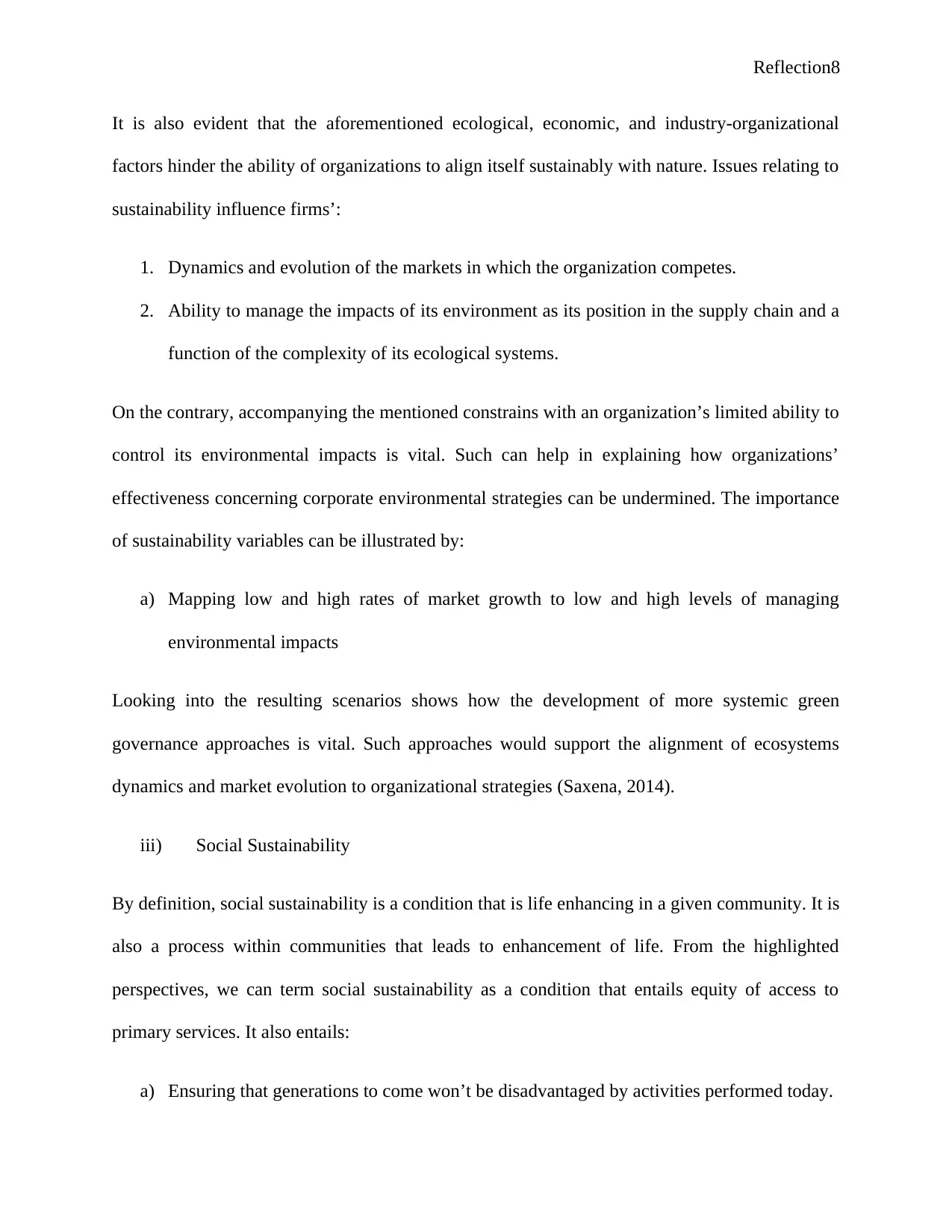
Reflection8
It is also evident that the aforementioned ecological, economic, and industry-organizational
factors hinder the ability of organizations to align itself sustainably with nature. Issues relating to
sustainability influence firms’:
1. Dynamics and evolution of the markets in which the organization competes.
2. Ability to manage the impacts of its environment as its position in the supply chain and a
function of the complexity of its ecological systems.
On the contrary, accompanying the mentioned constrains with an organization’s limited ability to
control its environmental impacts is vital. Such can help in explaining how organizations’
effectiveness concerning corporate environmental strategies can be undermined. The importance
of sustainability variables can be illustrated by:
a) Mapping low and high rates of market growth to low and high levels of managing
environmental impacts
Looking into the resulting scenarios shows how the development of more systemic green
governance approaches is vital. Such approaches would support the alignment of ecosystems
dynamics and market evolution to organizational strategies (Saxena, 2014).
iii) Social Sustainability
By definition, social sustainability is a condition that is life enhancing in a given community. It is
also a process within communities that leads to enhancement of life. From the highlighted
perspectives, we can term social sustainability as a condition that entails equity of access to
primary services. It also entails:
a) Ensuring that generations to come won’t be disadvantaged by activities performed today.
It is also evident that the aforementioned ecological, economic, and industry-organizational
factors hinder the ability of organizations to align itself sustainably with nature. Issues relating to
sustainability influence firms’:
1. Dynamics and evolution of the markets in which the organization competes.
2. Ability to manage the impacts of its environment as its position in the supply chain and a
function of the complexity of its ecological systems.
On the contrary, accompanying the mentioned constrains with an organization’s limited ability to
control its environmental impacts is vital. Such can help in explaining how organizations’
effectiveness concerning corporate environmental strategies can be undermined. The importance
of sustainability variables can be illustrated by:
a) Mapping low and high rates of market growth to low and high levels of managing
environmental impacts
Looking into the resulting scenarios shows how the development of more systemic green
governance approaches is vital. Such approaches would support the alignment of ecosystems
dynamics and market evolution to organizational strategies (Saxena, 2014).
iii) Social Sustainability
By definition, social sustainability is a condition that is life enhancing in a given community. It is
also a process within communities that leads to enhancement of life. From the highlighted
perspectives, we can term social sustainability as a condition that entails equity of access to
primary services. It also entails:
a) Ensuring that generations to come won’t be disadvantaged by activities performed today.

Reflection9
b) Protection and valuing of disparate cultures
c) People’s participation in political activity in local levels.
d) Communication mechanisms for collectively identifying needs and strengths. However,
fulfilling such needs can be performed through political advocacy and community
actions. According to several studies, the processes involved making steps towards
achievement of the aforementioned conditions forms part of social sustainability.
Under social sustainability, it is crucial to understand that the vastly growing methods, concepts,
and tools in the field of sustainability show that there is need for a coordinating and structuring
framework. The framework will help in outlining an operational and unifying definition of
sustainability. On the contrary, such a framework began about 25 years ago. The framework is
currently known as the Strategic Sustainable Development Framework. On the contrary, since
the field of sustainability is large, its social dimensions as a framework are insufficiently based
on science and also partially operational. Social dimension is, therefore, need of further
development. In this case, we deal with an approach that is systems-based. This will help the
basis of argument regarding social sustainability (Worman and McCartney, 2015).
Since the dimension of social sustainability was developed, it has been studied alongside
‘sustainable development’. The same topic has also been associated with sustainable economic
growth, quality of life and environment. However, environmental and economic aspects of
sustainability are predominant to social dimensions. However, social dimensions tender for all
sustainability agendas. The same dimension would help meet the challenges between social and
economic development. Most issues arise from the fact that social sustainability can be identified
and defined in many ways (Scott, 2015).
b) Protection and valuing of disparate cultures
c) People’s participation in political activity in local levels.
d) Communication mechanisms for collectively identifying needs and strengths. However,
fulfilling such needs can be performed through political advocacy and community
actions. According to several studies, the processes involved making steps towards
achievement of the aforementioned conditions forms part of social sustainability.
Under social sustainability, it is crucial to understand that the vastly growing methods, concepts,
and tools in the field of sustainability show that there is need for a coordinating and structuring
framework. The framework will help in outlining an operational and unifying definition of
sustainability. On the contrary, such a framework began about 25 years ago. The framework is
currently known as the Strategic Sustainable Development Framework. On the contrary, since
the field of sustainability is large, its social dimensions as a framework are insufficiently based
on science and also partially operational. Social dimension is, therefore, need of further
development. In this case, we deal with an approach that is systems-based. This will help the
basis of argument regarding social sustainability (Worman and McCartney, 2015).
Since the dimension of social sustainability was developed, it has been studied alongside
‘sustainable development’. The same topic has also been associated with sustainable economic
growth, quality of life and environment. However, environmental and economic aspects of
sustainability are predominant to social dimensions. However, social dimensions tender for all
sustainability agendas. The same dimension would help meet the challenges between social and
economic development. Most issues arise from the fact that social sustainability can be identified
and defined in many ways (Scott, 2015).
⊘ This is a preview!⊘
Do you want full access?
Subscribe today to unlock all pages.

Trusted by 1+ million students worldwide

Reflection10
Reference
Capabilities and Competences (2017). Capabilities and Competences. [online]
Ifm.eng.cam.ac.uk. Available at: http://www.ifm.eng.cam.ac.uk/research/dstools/capabilities-
and-competences/ [Accessed 20 May 2017].
CWMIFG (2012). What are resources and competencies? | Innovation for Growth. [online]
Innovation for Growth. Available at: http://www.innovationforgrowth.co.uk/Blog/what-are-
resources-and-competences/ [Accessed 20 May 2017].
Ethical Standards. (2017). IMPLEMENTING EFFECTIVE ETHICS STANDARDS IN
GOVERNMENT AND THE CIVIL SERVICE’. [online] Available at:
https://www.oecd.org/mena/governance/35521740.pdf. [Accessed 20 May 2017].
Ethics. (2017). Importance of Ethics in Accounting & Financial Decision Making,” . [online]
Available at: http://yourbusiness.azcentral.com/importance-ethics-accounting-financial-decision-
making-4394.html [Accessed 20 May 2017].
Kader, M. (2017). Strategic Management (StratMgt). Open2study.com. Available at
https://www.open2study.com/courses/strategic-management [Accessed 20 May 2017].
Kaplan (2017). Critical success factors and core competencies. [online]
Kfknowledgebank.kaplan.co.uk. Available at: http://kfknowledgebank.kaplan.co.uk/KFKB/Wiki
%20Pages/Critical%20success%20factors%20and%20core%20competences.aspx [Accessed 20
May 2017].
Management, S. (2017). SMS | Strategic Management Society. Strategic management.net.,
Available at https://www.strategicmanagement.net/ [Accessed 20 May 2017].
McArthur, E. (2010). Diversity in the Workplace - Leading Association for Diversity
Conferences and Collaboration. Workforcediversitynetwork.com. Available at
http://www.workforcediversitynetwork.com/res_articles_managingdiversity_mcarthur.aspx
[Accessed 20 May 2017].
MSG Management (2017). Resources, Competencies and Distinctive Capabilities. [online]
Managementstudyguide.com. Available at: http://www.managementstudyguide.com/resources-
competencies-distinctive-capabilities.htm [Accessed 20 May 2017].
Pirtea, M., Nicolescu, C., & Botoc, C. (2009). THE ROLE OF STRATEGIC PLANNING IN
MODERN ORGANIZATIONS. Annales Universitatis Apulensis, Series Oeconomica, 11(2).
[Accessed 20 May 2017].
Reference
Capabilities and Competences (2017). Capabilities and Competences. [online]
Ifm.eng.cam.ac.uk. Available at: http://www.ifm.eng.cam.ac.uk/research/dstools/capabilities-
and-competences/ [Accessed 20 May 2017].
CWMIFG (2012). What are resources and competencies? | Innovation for Growth. [online]
Innovation for Growth. Available at: http://www.innovationforgrowth.co.uk/Blog/what-are-
resources-and-competences/ [Accessed 20 May 2017].
Ethical Standards. (2017). IMPLEMENTING EFFECTIVE ETHICS STANDARDS IN
GOVERNMENT AND THE CIVIL SERVICE’. [online] Available at:
https://www.oecd.org/mena/governance/35521740.pdf. [Accessed 20 May 2017].
Ethics. (2017). Importance of Ethics in Accounting & Financial Decision Making,” . [online]
Available at: http://yourbusiness.azcentral.com/importance-ethics-accounting-financial-decision-
making-4394.html [Accessed 20 May 2017].
Kader, M. (2017). Strategic Management (StratMgt). Open2study.com. Available at
https://www.open2study.com/courses/strategic-management [Accessed 20 May 2017].
Kaplan (2017). Critical success factors and core competencies. [online]
Kfknowledgebank.kaplan.co.uk. Available at: http://kfknowledgebank.kaplan.co.uk/KFKB/Wiki
%20Pages/Critical%20success%20factors%20and%20core%20competences.aspx [Accessed 20
May 2017].
Management, S. (2017). SMS | Strategic Management Society. Strategic management.net.,
Available at https://www.strategicmanagement.net/ [Accessed 20 May 2017].
McArthur, E. (2010). Diversity in the Workplace - Leading Association for Diversity
Conferences and Collaboration. Workforcediversitynetwork.com. Available at
http://www.workforcediversitynetwork.com/res_articles_managingdiversity_mcarthur.aspx
[Accessed 20 May 2017].
MSG Management (2017). Resources, Competencies and Distinctive Capabilities. [online]
Managementstudyguide.com. Available at: http://www.managementstudyguide.com/resources-
competencies-distinctive-capabilities.htm [Accessed 20 May 2017].
Pirtea, M., Nicolescu, C., & Botoc, C. (2009). THE ROLE OF STRATEGIC PLANNING IN
MODERN ORGANIZATIONS. Annales Universitatis Apulensis, Series Oeconomica, 11(2).
[Accessed 20 May 2017].
Paraphrase This Document
Need a fresh take? Get an instant paraphrase of this document with our AI Paraphraser

Reflection11
Price, S. (2011). Qantas unions stand up to management. [online] Greenleftweekly. Available at:
https://www.greenleft.org.au/content/qantas-unions-stand-management [Accessed 23 January
2018].
Saxena, K. (2014). Capabilities versus Competence: How are they Different?. [online] Available
at: https://www.linkedin.com/pulse/20141123155439-7430899-capabilities-versus-competence-
how-are-they-different [Accessed 20 May 2017].
Scott, S. (2015). Gender Differences Within the Workplace. Smallbusiness.chron.com. Available
at http://smallbusiness.chron.com/gender-differences-within-workplace-10512.html [Accessed
20 May 2017].
Worman, D., & McCartney, C. (2015). Managing Diversity in the Workplace | Reports | CIPD.
CIPD. Retrieved 31 March 2017, Available at
https://www.cipd.co.uk/knowledge/fundamentals/relations/diversity/age-diversity-insights-report
[Accessed 20 May 2017].
Price, S. (2011). Qantas unions stand up to management. [online] Greenleftweekly. Available at:
https://www.greenleft.org.au/content/qantas-unions-stand-management [Accessed 23 January
2018].
Saxena, K. (2014). Capabilities versus Competence: How are they Different?. [online] Available
at: https://www.linkedin.com/pulse/20141123155439-7430899-capabilities-versus-competence-
how-are-they-different [Accessed 20 May 2017].
Scott, S. (2015). Gender Differences Within the Workplace. Smallbusiness.chron.com. Available
at http://smallbusiness.chron.com/gender-differences-within-workplace-10512.html [Accessed
20 May 2017].
Worman, D., & McCartney, C. (2015). Managing Diversity in the Workplace | Reports | CIPD.
CIPD. Retrieved 31 March 2017, Available at
https://www.cipd.co.uk/knowledge/fundamentals/relations/diversity/age-diversity-insights-report
[Accessed 20 May 2017].
1 out of 11